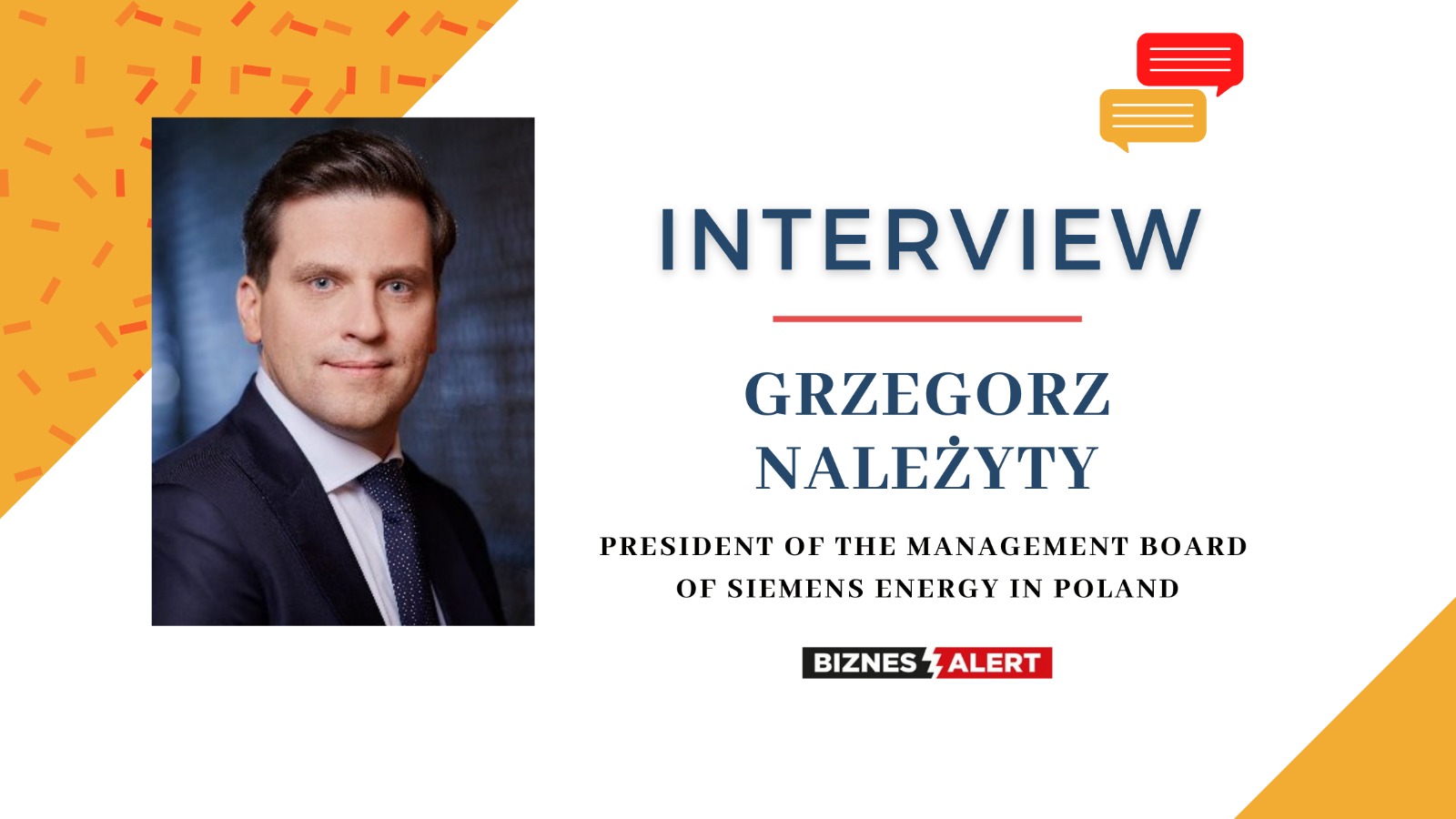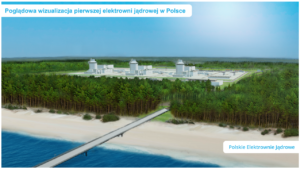The future of natural gas power stations depends on hydrogen. In the coming decades this fuel may replace gas in our heating and power plants. Europe’s financial institutions do not want to finance natural gas anymore, and are introducing new emission requirements. Blending natural gas with hydrogen is an opportunity to lower the emissions of gas power plants, and those in Poland are ready for this change – Grzegorz Należyty, CEO of Siemens Energy, says in an interview with BiznesAlert.pl.
BiznesAlert.pl: The European Investment Bank (EIB) will participate in the implementation of the European Green Deal. In Poland gas will be used as a transition fuel for at least three decades. Whereas after 2021, the EIB will stop financing gas investments. Only plants with emissions at 250g/KWh will be able to apply for funding. Currently gas-fired power stations emit about 300g of CO2 per kWh of generated electricity. Does Siemens, one of the leading providers of gas turbines in Europe and Poland, think this means the end of the sector?
Grzegorz Należyty, CEO of Siemens Energy: This is technically possible. Whenever we take part in tenders, we create solutions on the basis of technologies for high efficiency cogeneration, which produces a high volume of heat for households or industry. We are able to achieve the 250 kg/MWh requirement, especially for the latter group of clients. In case of CHP plants it is possible to generate heat together with electricity.
According to EIB’s guidelines, investments in CHP and heating plants, which can also generate electricity, will be able to apply for funding. Could Poland’s smaller heating plants reach for a technology that caps emissions at 250g/KWh?
Economic viability is always the underlying issue. The most important factor are the returns to scale, i.e. how many orders can be placed at a factory, and how many turbines of this kind the facility is capable of producing. The more scattered the production, the higher the price of turbine manufacturing. EIB, like you mentioned, will no longer provide long-term financing for technologies based solely on gas. Therefore, the turbines have to be capable of co-firing hydrogen. Our turbines are already adapted to do this. They are able to co-fire up to 50 percent of hydrogen and 50 percent of gas. For some the ratio is 80 or 70 percent of gas to 20 or 30 percent of hydrogen. However, considering our future expenses, these parameters will change to hydrogen’s advantage. Our end goal is to produce turbines that use only hydrogen. The question is whether we are able to encourage Polish companies to buy such turbines. A turbine constitutes between 10 and 15 percent of the total investment cost, whereas the remaining components can be provided by Polish companies. When it comes to contractors, today Polimex is gaining ground after a downturn, whereas Rafako is facing difficulties. These companies have to be restructured. The question is whether there are other companies that could realize such investments. Today the energy sector needs to face the challenge of building large facilities. We will see whether it will share the fate of Polish companies that built highways, and which, after a wave of bankruptcies, were replaced with European firms. Restructuring could help the energy companies succeed at building new power and heating plants, and then use this potential to enter foreign markets.
What is the cost of building new CHP power plants that meet the EIB standards, i.e. the 250 kg/MWh emission maximum?
The D tariff, which applies to the heating market, causes a situation where the local heating plants owned by local authorities are institutions of the public good, not companies that make money. Because of that, the heating plants are unable to make investments to meet the new emission standards. The Andrychów CHP plant is an example here, as last year it was unable to meet the BAT emission standards. It faced financial difficulties due to CO2 emissions costs. They exceeded the company’s profits, regulated by the tariff, at a level of 3 percent. Thus, these companies are not able to save enough money for new investments. This is why external support is necessary. So, we have three technical solutions to provide heating. The main one for large cities with big heating networks, is cogeneration based on gas. It seems to be very efficient, and is able to lower the emissions below 250 kg/MWh. Whereas, there are two solutions for smaller towns. They can, if their geological conditions allow, use geothermal energy, or benefit from the electrification of heating. At this stage, the latter option is often out of reach. Coming back to your question about the price – when it comes to the needs of Polish towns, we are talking about a capacity between 20 and 150 MW. The tenders that are now in progress, e.g. in Bydgoszcz, pertain to a project that has over 50 MW. We delivered a 138 MW CHP power plant for Gorzów Wielkopolski. Its cost was around a few hundred million, starting from PLN 150-200 m up to 700 m. The differences are so big, because they stem from technical and infrastructural conditions, access to gas or power evacuation.
According to forecasts by analysts, considering the climate and decarbonization policy, in a few years in Poland and Europe gas power plants will have a huge capacity, but the demand for gas will be dropping, just like the demand for coal is today. If that is the case, how to manage those plants, or how to fill in this gap?
It seems reasonable to build gas power plants today. Still, Europe will take the low-emission path only because it wants to arrive at zero emissions. The European grids already deliver a lot of green energy, and that figure will continue to grow. It will be similar in Poland, thanks to offshore wind farms with a capacity of ca. 10 GW. Onshore wind farms will expand as well. PV, which can stabilize the grid in the summer, is also on the list. The energy from renewable sources has a priority in the grid. However, gas will play the supporting role, as it will stabilize the demand for energy. At this stage we do not have a solution different to energy storage. The more green energy will be generated, the more energy from gas we will need at this stage to replace coal-fired power generation. However, if we take into account the EU’s hydrogen strategy, we will notice that its goal is to develop green hydrogen. Brussles assumes that by 2023 Europe will have an additional 4 GW of capacity and by 2030 as much as 40 GW in hydrogen generation. This means, gas power plants will be decarbonized in the next stage. Natural gas will be replaced with hydrogen. We assume that in the majority of gas-fired power stations it will be technically possible to replace gas with hydrogen. The investment cost that involves the transition from one fuel to another is not huge, it is actually unnoticeable in comparison to the total investment cost. Our SGT 800 turbine, which has a capacity of 50 MW in Gorzów Wielkoposki is adapted to using gas and hydrogen, each at 50 percent. In the next decade, we will have to do a review to see which clients use what kind of generation fleet, and how we should invest our money when it comes to technologies related to turbine decarbonization. At the end of 2030, those gas-fired power stations, which will continue to operate, will be decarbonized.
You mentioned Gorzów Wielkopolski. What is the situation in Płock, where Siemens is building a gas power plant for PKN Orlen?
The gas power plant in Płock has a capacity of 600 MW and its ability to co-fire hydrogen together with natural gas is below 50 percent.
You mentioned that the gas power plants, which will continue to generate power after 2030, will have to switch to hydrogen after that date. How will hydrogen be supplied to them?
There are a few ways. First, hydrogen can be delivered via the existing gas pipelines. The second solution is to generate H2 near the power plant from renewables, because it has to be green hydrogen. We can imagine a situation where an electrolyzer is built next to the plant to work during the so-called night valley, when there is an over-supply of green energy. However, today hydrogen is too expensive to be profitable. Blending hydrogen with natural gas makes sense, because it decreases the high costs of fuelling the power plant, and at the same time, it lowers emissions and climate policy costs. If we completely replaced natural gas with hydrogen today, the cost of CO2 emissions per ton would have to be at about EUR 350 to make the switch profitable. That won’t happen. Currently the emission allowances cost up to EUR 30 per one ton. A blend with 80 percent natural gas and 20 percent of hydrogen minimizes the potential cost of the fuel for the power plant, and by decreasing emissions lowers CO2 emissions allowances costs. This optimizes the power plant, when it comes to its financial situation and its impact on the environment.
PKN Orlen and Energa are planning many gas investments. Apart from the 750 MW gas power plant in Ostrołęka, the plans include units in Gdańsk, Grudziądz and Elbląg. Is Siemens Energy planning to take part in all of those four tenders?
Our offer includes a technology, which can contribute an added value to the places you mentioned and may be attractive, when it comes to generating the best economic value. However, the investors are the ones who need to assess that. We will participate in the majority of the tenders to really show the value of our technologies. We have already built a 600 MW combined cycle power plant in Płock. For PGE we constructed the Energia Ciepła power plant in Gorzów Wielkopolski. These technologies have been verified in Europe and in Poland together with comprehensive maintenance services. The investors are yet to make their decisions about the above projects, if they are positive the probability that we will be interested in the tenders is very high.
Polenergia, Siemens Energy and Siemens Gas and Power GmbH & Co. GK declared last June, they would cooperate closely to develop state-of-the-art technologies , including for gas and hydrogen, to decarbonize industry and the power sector. Could you spill some details about the goal of your cooperation when it comes to hydrogen?
Currently we are looking for partners in Poland, in this case – Polenergia, that are interested in developing hydrogen technologies and in searching for ways to generate this fuel. For us Polenergia is a company that is in reality decarbonized, it has PV, onshore wind farms and is preparing with its partner to build offshore wind farms. It is heading towards implementing new technologies and is looking for ways to apply them. This strategy is in line with my company’s expectations with regard to looking for opportunities to build installations. The cooperation complements Polenergia’s strategy on entering the hydrogen sector and investing in high efficient cogeneration. We are working with other companies on the Polish market when it comes to hydrogen as well. In cooperation with the Ministry of Development, our partners submitted projects as part of the EU’s IPCEI program, which fit in with the value chain of hydrogen technologies and systems. The applications pertain to using hydrogen to decarbonize district heating and the energy sector as such. We supported those applications in their technical aspects, and we expect that if they turn out to be profitable, they will be implemented. So, if you are asking about project implementation, my answer is that if Polenergia presents a business plan for an investment, we are ready to talk about developing it. Our cooperation will result in the usage of green hydrogen.
In the next decade Europe is planning to invest in increasing numbers of electrolyzers built near RES installations. Can this change the European energy sector, just like gas turbines once did?
Electrolyzers may turn out to be not just a temporary fix, but our target solution. Two conditions need to be met to make hydrogen the fuel of the future from the point of view of economics. The business model related to hydrogen is based on large economies of scale. A lot has to be produced to reduce the unit cost to a level that will be profitable and competitive in comparison to gas. So, if we generate about 10 GW from offshore wind farms, a few GW from onshore farms and PV, the it may turn out that there will be a substantial over-supply in the night valley system. In such a case investors may find it unprofitable to feed the energy into the grid, and they will turn to generating hydrogen as the second product and store it. Once the economies of scale emerge, a revolution in transport will occur and trains, buses and ships will switch to hydrogen, and so will the energy sector. A similar process occurred with regard to oil in the past, which found a wide range of applications.
Nevertheless, using hydrogen as fuel to generate energy still poses many challenges, such as the ability to control the gas and the technology. Is it possible to manage hydrogen today in a way that minimizes threats such as explosions?
At this stage it is very difficult, it has been done in individual cases, but this issue still needs discussions and scientific research. This topic is worth a more comprehensive comment. We talked about hydrogen in the energy sector, which to a degree stems from EU policy, the European Green Deal. This path changes the foundations of Europe’s economies. It may contribute to the emergence of many small, innovative companies, which will have ready technology for co-firing, storing and transmitting hydrogen.
Today’s popular quip is that hydrogen is the 21st century oil for transport. Can it become the 21st century coal for the energy sector?
There are no reasons why not, but when it comes to the technology, transport and storage there is a number of technical challenges.
Interview by Wojciech Jakóbik and Bartłomiej Sawicki









